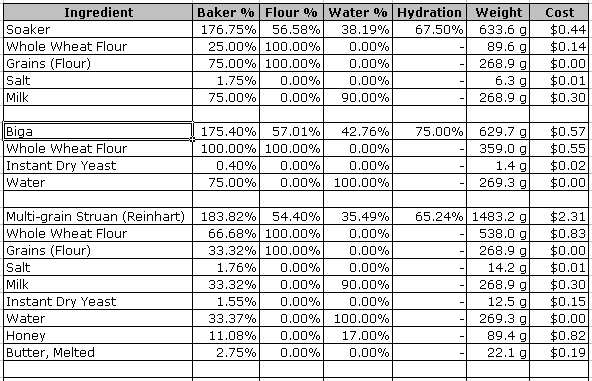Introduction
When a formula uses preferements it is often hard to see, at a glance, what the overall composition of a dough is. Hydration of the overall dough determines the stiffness of the dough, for example, but if parts of the hydration come from preferments, one cannot simply look at the percentage of water in the final dough. A similar situation exists if one or more preferments use salt, etc.
In addition, it is not easy to see the total amounts used of any unique ingredient because an ingredient may be used in both a preferment and the final dough etc. This makes it a little hard(er) to determine how much of each ingredient is needed before you start baking.
The purpose of the "Analysis" worksheet is to provide you with this information. It presents the information separately for each preferement, as well as for the overall dough. Here is an example:

The information on this worksheet is updated whenever the "Recipe" worksheet is updated and this worksheet is never edited.
Calculation
The analysis is computed by first computing the analysis for each preferment. Next the details for each ingredient in the final dough are determined. If an ingredient refers to a preferment, all necessary information is now available. The calculation proceed by replacing the one ingredient referring to the preferment by the complete list of ingredients from the preferment. Finally, information for identical ingredients is added together so that each ingredient only appears once in the final list.
Based on earlier calculations on the "Recipe" worksheet, weights for all ingredients are known. The "Lookup" worksheet is now used to determine the water content (H2O%, which is NOT the same as hydration) and flour content (Flour%). This is so that these two items can be added for all ingredients in the overall dough. We then obtain the overall hydration by dividing the summed H2O% and Flour% by the summed Formula% (after all we want flour to be 100%).
In the example's "Soaker" preferment you will notice that the milk only contains 90% water (the rest is called milk solids). The flour contributes 100% out of 176.75%, or 56.58%, and likewise water is 90% time 75% divided by 176.75, or 38.19%. Thus the hydration is 38.19/56.58 or 67.5%.
The total liquid contribution to the overall dough is 90% times 268.9 (milk) + 269.3 (water) + 17% times 89.4 (honey) or 526.508 gram. Total flour is 538 + 268.9 = 806.9 so overall hydration is 526.508 / 806.9 or 65.25%.
You can also see that overall salt is 1.76%, which is in the typical range for bread, but not as high as some at 2%. Finally, notice the overall cost of $2.31, dominated by the cost of the flour and honey (and milk). Note that I did not list a specific cost for the additional grains (because this is a rather ambiguous term). If you would like to minimize your cost, this tells you to get cheaper flour and a cheaper honey, or substitute.